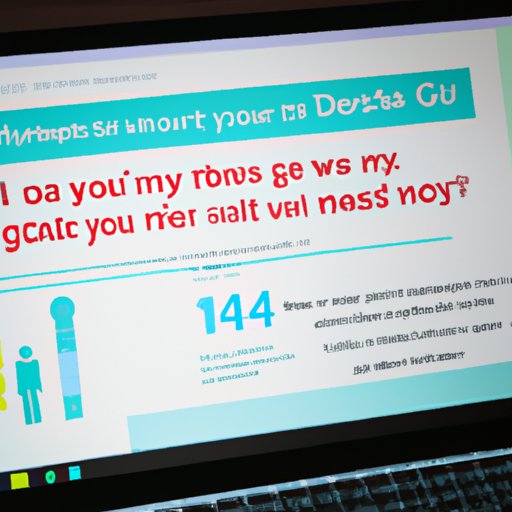Introduction
23andMe is a popular DNA testing service that provides users with genetic insights about their health, ancestry, and more. By analyzing a person’s genetic information, 23andMe can provide detailed reports on things like disease risk, carrier status, and even physical traits. This article will explore how 23andMe works, the benefits and potential risks of using the service, and how it compares to similar services such as AncestryDNA and MyHeritageDNA.

Exploring the Science Behind 23andMe
Understanding how 23andMe works requires an understanding of the science behind it. In order to analyze a person’s DNA, 23andMe uses a process called “genotyping.” This involves examining a person’s entire genome, which is made up of roughly 3 billion base pairs of DNA. These base pairs contain the instructions for building and running the human body.
23andMe looks at over 500,000 locations in the genome, known as “single nucleotide polymorphisms” (SNPs). Each SNP represents a single change in the sequence of a person’s DNA, and these SNPs are associated with different traits, diseases, and other characteristics. By looking at these SNPs, 23andMe is able to provide an analysis of a person’s genetic makeup.
How to Use 23andMe
Using 23andMe is a relatively simple process. The first step is to sign up for an account on the 23andMe website. After signing up, the user will receive a kit in the mail that includes everything they need to collect a sample of their DNA. This typically involves swabbing the inside of the cheek with a special brush.
Once the sample has been collected, it is sent back to 23andMe in a pre-paid envelope. Once the sample has been received, 23andMe begins the analysis process. This typically takes 6-8 weeks, after which the user will receive their results via email.
Benefits of Using 23andMe
One of the primary benefits of using 23andMe is gaining insight into one’s health. By looking at a person’s genetic makeup, 23andMe is able to provide detailed reports on a person’s risk for developing certain diseases, their carrier status for inherited conditions, and even their response to certain medications. This can be incredibly useful for those who want to learn more about their health.
Another benefit of using 23andMe is the ability to track family history. By comparing a person’s DNA to others in the 23andMe database, it is possible to discover distant relatives and gain an understanding of the family’s geographic origins. This can be a great way to learn more about one’s family tree.
Finally, 23andMe can be used to discover new relatives. By connecting with others in the 23andMe database, it is possible to find people who share DNA and may not have known about each other before. This can be a great way to connect with distant relatives and learn more about one’s family history.
Potential Risks of Using 23andMe
Despite the many benefits of using 23andMe, there are some potential risks to consider. One of the most significant concerns is the accuracy of the results. While 23andMe does its best to provide accurate results, the accuracy of any genetic test is never 100%. There is always a chance that the results could be inaccurate, so it is important to take them with a grain of salt.
Another potential risk of using 23andMe is privacy concerns. 23andMe collects a lot of personal data, including a person’s genetic information. It is important to make sure that this data is kept secure and not shared with anyone without the user’s explicit consent.

Comparing 23andMe to Similar Services
23andMe is not the only DNA testing service available. Two of the most popular alternatives are AncestryDNA and MyHeritageDNA. Both of these services offer similar features to 23andMe, including the ability to track family history and discover new relatives. However, they differ in terms of cost and the type of information they provide. For example, AncestryDNA offers more detailed reports on a person’s ethnic background, while MyHeritageDNA focuses more on finding living relatives.
Privacy Considerations with 23andMe
When using 23andMe, it is important to be aware of the privacy considerations involved. 23andMe takes measures to ensure that a user’s data is kept secure, including encryption and access controls. Additionally, 23andMe has a strict terms of service that outlines how the company will use and protect a user’s data.
It is also important to remember that 23andMe does not own a user’s data. A user can choose to opt-out of sharing their data with 23andMe or delete their data at any time. Additionally, 23andMe will never sell a user’s data to third parties.
Conclusion
23andMe is a popular DNA testing service that provides users with insight into their health, ancestry, and more. By analyzing a person’s genetic information, 23andMe is able to provide detailed reports on things like disease risk, carrier status, and physical traits. However, it is important to be aware of the potential risks of using 23andMe, such as inaccurate results and privacy concerns. Additionally, it is important to be aware of the terms of service and data security measures that 23andMe has in place.
Overall, 23andMe is a great tool for those who want to learn more about their genetics and family history. However, it is important to consider the potential risks and compare it to similar services such as AncestryDNA and MyHeritageDNA before making a decision.
(Note: Is this article not meeting your expectations? Do you have knowledge or insights to share? Unlock new opportunities and expand your reach by joining our authors team. Click Registration to join us and share your expertise with our readers.)
